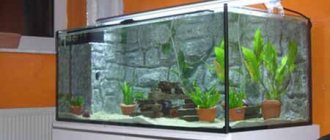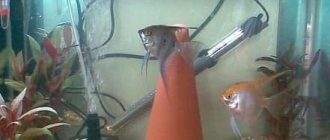When repairing aquariums, only safe compounds that meet a number of requirements are used. It is necessary to take into account how long it takes for the aquarium sealant to dry, how resistant it is to moisture, and whether the glue contains toxic components. It is advisable to choose special products, of which there are several types.
When repairing aquariums, aquarium sealant is used.
Aquarium sealant
Many aquarists prefer not to buy aquariums for their aquatic pets, but to make them themselves. In this situation, it is extremely important to choose the right aquarium sealant, since the comfortable living of the fish in the water will depend on its quality. There is an opinion that the sealant is dangerous to the health of the inhabitants of the aquarium. This is not true, since it hardens very quickly and does not release toxic substances into the water.
Composition of aquarium sealant
Aquarium silicone sealant contains dyes, various fillers, a vulcanizing component, various enhancers and silicone rubber. The quality of the sealant, as well as its cost, depends on the presence of certain components in the composition.
One of the most important components is the vulcanizing component. It determines how firmly the surfaces will stick together, what the seam will be, etc. It is important to remember that when treating glass with silicone sealant, a vinegar smell is released, and in order not to harm the fish, after gluing the aquarium, you should keep it in water for several days, constantly changing it. There are sealants that have absolutely no odor, but their price is too high, and aquarists prefer to use silicone.
Types of aquarium sealants
Before you go shopping for material, you need to find out which aquarium sealant is best. The most common types are silicone and acrylic sealants. The latter are not entirely suitable for gluing glass, although some aquarists use them successfully. The fact is that acrylic sealant does not like moisture, and its adhesive strength is not the same as that of silicone.
Silicone sealant is an excellent tool for creating or repairing an aquarium. It has a long service life, adheres well to any surface, and is quite elastic.
There are also acid sealants, but they are not recommended for use for interior work in an aquarium. They emit a strong vinegary odor and can harm fish.
How long does it take for aquarium sealant to dry?
Beginner aquarists who decide to make a fish aquarium with their own hands often do not know how long aquarium sealant can take to dry. It all depends on how thick the layer you are making. Experts recommend not making it thicker than two millimeters, but here too it all depends on what thickness of glass is used. So, a layer 2 mm thick will dry for a maximum of two days. Do not forget that after drying the aquarium should be soaked in water to remove the smell. Silicone sealant is used at temperatures from five to forty degrees Celsius. At sub-zero temperatures, it simply will not glue surfaces well.
Features of choice
Silicone sealants are divided into acidic and neutral. The former have a strong vinegar smell and are marked “A” on the tube. Neutral sealants have no odor; these are the ones you need to buy to repair your aquarium yourself. They cost more than acidic ones; a product cannot be too cheap. Sealants have the following properties:
- durable, elastic, moisture resistant,
- withstands changes from -70 to +70 degrees,
- do not tolerate staining - the paint literally rolls off,
- They cannot stand applying a new layer to an old one; they will have to completely clean the product and degrease the base.
When purchasing, you need to pay attention to the colorlessness of the sealant (colored options with added artificial pigments are not suitable), and to a good residual shelf life. The instructions must indicate that the product can be used to glue aquariums, which will confirm its safety.
Silicone for aquariums instructions
STORAGE LIFE. 24 months from the date of production in original, unopened packaging at temperatures between 0oC and 25oC in a dry place, protected from frost. PACKING. 310 ml, 600 ml. It is intended for filling sections, gaps between a shower stall, hydrobox, bathtub or sink and walls, for sealing certain types of pipes, corner joints of ceramic tiles for a bath. This type of silicone sealant is also called “sanitary” because it contains a fungicide, which, even over time, is not susceptible to mold and other “nasties” that arise from constant high humidity. Search for a product in this category Sort by: name ( ascending descending price ( ascending descending rating ( ascending descending ) Universal glue. Sticks everything to everything (except artificial stones made of polyethylene and polypropylene). Aquarium silicone. Black. Products and equipment for aquariums, terrariums , pond. Characteristics and scope of application of siopor. How to choose wood for construction? A rounded log is a high-quality log house for centuries. Dry profiled timber from the manufacturer is always positive feedback. Penotherm for baths and saunas: technical parameters and installation features. Treatment of wood against rotting with its own antiseptic. The marking "N" (from the English word neutral neutral) means that this is a neutral sealant. The advantage of neutral sealant is that it can withstand temperatures up to plus 400 C. Its heat-resistant indicators in the positive ratio are the maximum among all types of sealants. When using an acid sealant, acetic acid is released. Some materials may come into contact with acetic acid and lose their integrity and become deformed. In such cases, the use of an acid sealant is not advisable. For the above reason, acid sealant should not be used on surfaces made of zinc, copper, brass, lead, etc. Silicone sealant-adhesive does not require treatment of the bonded surfaces with a primer; its adhesion is so good that it is able to withstand significant deformation of the seam. Sharp turns or displacement of the seam are not a problem for silicone sealant, since its fibers can elongate up to 900 during stretching. Bitumen sealant is easy to use, elastic, and protects the surface from rust and moisture. It is not affected by atmospheric influences and has good adhesion properties. Used in sealing roofing joints, all types of joints and cracks. See how to wipe off silicone sealant: We all often face a problem that arises from building materials, one of which is silicone and bitumen sealants, which, it would seem, cannot be removed, erased, washed, etc. with anything.
If you scrub a painted surface with white spirit, the paint will come off along with the sealant. Instructions 2. Penta-840 is an ideal product (the so-called silicone remover, which is used in wide temperature ranges and in cases of freezing (which leads to an increase in shelf life) thaws and performs its function. This high-temperature sealant is suitable for use in the construction of a bathhouse from foam blocks with your own hands As for silicone for aquariums, instructions for the sanitary properties of a neutral sealant, we can say with confidence that it is resistant to fungal attack, i.e., has a high degree of bacterial protection.Acid sealant Titan Acid sealants have some price advantage compared to neutral sealants. So, on average, one cartridge of acid sealant with a capacity of 300 ml costs $2.5 US. Acid sealants have an important feature that must be taken into account when using them. Primary setting (a film forms on the sealant) occurs within 20 minutes. Silicone for aquariums instructions (- but it’s too early to fill the aquarium. And a couple more tips: When buying silicone for aquariums, pay attention to the release date and expiration date. Apply the sealant to the desired surface that we are sealing and wait until it dries. How long does silicone sealant take to dry? Based on the technical characteristics, the drying time of the first layer, that is, before the film appears, is 15-20 minutes. This type of sealant is used in the manufacture of aquariums, terrariums and other glass products. Silicone sealant for bathtub or plumbing, also thanks to new technologies, is lightweight and easy to use, has good adhesive properties, is elastic and has antifungal properties and prevents infectious reproduction. Sealant Titan For aquariums (Tytan) DESCRIPTION. TYTAN aquarium sealant is a high quality, one-component silicone sealant designed for the assembly and sealing of aquariums and terrariums. The cured sealant is safe for aquarium inhabitants: fish, reptiles. The sealant is especially indispensable when sealing cracks in roofing materials, in the base and in the foundation of a bathhouse. Bitumen sealant is often used to seal the drainage system in greenhouses. How can I wash and remove silicone sealant without damaging the surface? Fish Accessories silicone for aquariums instructions AQUAEL Adhesive silicone for aquarium Aquael Aquarium silikon, (black).
What to do for home repairs
If the aquarium is of small capacity, then it is better to replace it. If the volume exceeds 100 liters, repairs will cost less.
The difficulty of repair is determined by the cause of the leak. If the bottom is damaged, you can fix it by placing a glass patch that will cover the crack. If the glass is damaged, new glass is installed on the side.
A crack in the sealant requires special attention. When a leak occurs in this area, the entire seam changes. First, the seam is cleaned of the old sealant, since the new silicone does not stick well to the old one.
With proper, careful repair and proper further operation, an aquarium that has served for no more than 5 years will last another 3-4 years.
In preparation, its inhabitants are moved to another container along with water, plants, and toys. Pebbles and sand are also removed from the container, after which the entire aquarium is thoroughly washed.
To identify cracks that have gone undetected, a leak test is performed before repairs. To do this, a sheet of paper is applied to each joint in turn. Even a small wet spot will indicate a small leak that needs to be fixed.
Before sealing the joint, the seam is cleaned. For a large gap, use a sharp knife, for a small gap, use a blade.
The edges of the walls, from which the old composition has been removed, are degreased. It is better to seal the walls of the container next to which the repair will be carried out so that the seam is neat.
Experts advise using sealant with reserve.
This will reduce the likelihood of a new leak occurring in the future. Remaining gel can be removed using a knife or blade.
When filling seams, it is best to seal the sealant by pushing it inside using a nail file or scissors.
You must carefully follow the instructions that come with the selected product (the use of the composition must imply constant contact with water) and follow them during repairs.
For the sealant to dry, you need to wait 24-36 hours. After this, the seams are checked again for leaks. If the paper remains dry, there are no gaps.
This waiting period is explained by the need for the product to dry and its toxicity. During this time, harmful substances evaporate, so the inhabitants of the aquarium will not be harmed.
If there are no conditions for keeping them and you need to urgently return them to the aquarium, it is recommended to increase the intensity of the air supply.
When repairing a container, its inhabitants are placed in a container with water similar in composition to the one that was in it. If possible, you can agree to temporarily keep them in a pet store. The need to move attributes (pebbles, toys) is interpreted by the fact that a sudden change in environment causes stress in animals.
In conclusion, it must be said that timely repairs increase the life of the aquarium.
An aquarium is a beautiful, but expensive decoration for an apartment, so many breeders try to make it themselves. A high-quality tank can be obtained if a person has some construction experience and high-quality materials. Our company’s specialists will tell you how to properly glue an aquarium yourself.
Aquarium fish lovers and pet store owners probably know that to seal and assemble aquariums you need a special product called a sealant. On sale today in a huge assortment you can find mixtures that have different compositions and unique properties. If we are talking about acidic silicone sealant, then it can be used not only for aquariums, but also for finishing shower cabins, display cases and for gluing glass structures. It is noteworthy that after hardening, this mixture is not capable of causing harm to living organisms, and it can be used even on those surfaces that during operation will come into contact with food and drinking water.
Aquarium sealant is characterized by the fact that it does not spread after application and does not slide along the seam, this makes its use more convenient. The sealant has high adhesive ability, excellent adhesion to: ceramics; enamels; fiberglass; tiles and many other materials. It hardens quickly, allowing the bonded structures to be used immediately after completion of this stage.
Bonding and repairing an aquarium
Repairing an aquarium at home will not cause difficulties if you follow some rules:
- cover the work surface with a protective film;
- use masking tape, moving away from the edges, to protect the glass parts of the aquarium;
- treat the areas to be glued with a degreaser, acetone or alcohol;
- Apply the sealant in a thin layer and carefully level it;
- connect the walls of the container with the bottom in the following sequence: first the front wall, then the right, then the left and finally the back;
- fix the product for the period specified in the description using any tightening means;
- Before the glue dries, remove excess glue with a construction scraper;
- After drying time (approximately 24 hours), fill the container with water, check if the seams are leaking and drain the water.
“If used glass is used when creating an aquarium, they must be thoroughly cleaned of previous adhesive sealants using acetone and a sharp scraper.
Only dry parts are treated with sealant, otherwise the connection will be of poor quality.”
What to do with a cracked aquarium? The order is:
- inspect the leak site and remove condensate;
- move fish and ornamental plants to another place and pour out the liquid;
- dry the cracked area and degrease it;
- seal the defect with sealant and carefully level the seam at the gluing site with a spatula;
- wait until completely dry.
What requirements must aquarium glue meet?
In principle, two pieces of ordinary glass can be glued together using regular superglue or using other synthetic adhesive products. However, if we are talking about repairing or making an aquarium, then not every adhesive composition is suitable. And there are a number of reasons for this.
- Firstly, the walls of an operating aquarium experience a fairly large lateral pressure of the water mass. If, after drying, the glue at the junction of the walls becomes too hard, then there is a possibility of kinks and cracks appearing along the seam line.
- The second requirement is reliability.
Properties and composition of silicone glue
Otherwise, this type of glue is called silicone. Due to its versatility, silicone is widely used for household purposes. And in aquariums too. This is the substance used to glue aquariums together and glue cracks.
In terms of composition, this sealant is very complex. We will not delve into the jungle of chemical science now, but in general we can say that:
- The base consists of rubber, which, when dried, can withstand high pressure.
- Strength enhancer of a substance.
- Sometimes, a coloring matter.
- Vulcanizer.
- Plasticizer.
Types of sealants for aquariums
Acrylic sealants have low adhesion to glass and are also susceptible to moisture. Butyl is well suited for glass, but its tensile strength is low. Polyurethane, polysulfide and bitumen sealants are used mainly in construction. Acidic sealants release some acetic acid into the external environment.
Silicone sealants are a universal means of gluing and are often used in everyday life. They have a long service life, are elastic, and adhere perfectly to any surface. Therefore, if the question arises about what kind of sealant to glue the aquarium with, the answer is clear - silicone.
Advantages of silicone aquarium sealants
It is silicone sealants that are always used today when gluing terrariums and aquariums. They are completely non-toxic and no protective clothing is required when working with them. They will also not release harmful substances into the external environment, including when interacting with water.
As for aquarium glue, it should also be silicone. The glue is quite easy to use. It hardens very quickly, in 20 minutes - under the influence of moisture in the air. In a day, polymerization will be completely completed. The seams are super strong: to destroy them you need to apply a force of 200 kilograms! At the same time, silicone glue retains its elasticity, which is important - rigid seams are more susceptible to cracks and destruction.
If the aquarium leaks
What to do if there is a leak or crack in the aquarium? Don't panic, but start saving the fish house! If the crack is small and appears in the upper part of the reservoir, then it is simply covered with silicone. If a seam is leaking or a crack appears lower down the wall, then first, all living creatures are removed from the reservoir. If the glass is severely damaged, then it is better to replace it with a new one.
How to seal the aquarium yourself if the leak is at the top of the seam? The stages of work are very simple. The repair will require blades, masking tape, degreaser and aquarium sealant.
- Break the blade in half lengthwise, use it to pierce the old sealant at the leak site and carefully remove it. It is also worth cleaning a little below and a little above the damage site.
- Degrease the glass and cover it with masking tape along the seam so as not to stain too much.
- Seal the leak with sealant, remove the tape, and let the glue dry.
- Once dry, check for leaks. If it is not there, then the aquarium can be used. Otherwise, the procedure is repeated.
Popular manufacturers
The sealants presented in stores vary in composition, quality, and price. Among the materials that users most often choose, it is worth mentioning the following:
- Chemlux 9013 . A fast-acting composition, incredibly stable, durable, and can be stored for a long time even when opened. One tube is enough for an aquarium up to 3000 liters.
- Germent moment . 100% silicone product, ideal for aquariums and terrariums. Withstands contact even with sea water, reliably seals joints, including those exposed to vibration. Can be used on regular, laminated, glazed glass.
- Soudal A.Q. Produced in Belgium, safe for any living organisms. It can glue not only glass, but also plastic, wood, metal, and ceramics. It is highly water resistant.
- KimTec (Kim Tek). As the product is exposed to air, it turns into soft-elastic silicone rubber, resistant to any adverse factors. Suitable for sealing terrariums, aquariums, showcases, glass art products.
- Krass. An inexpensive product, elastic and moisture-resistant, but has a sour odor due to the presence of a small amount of acids. Suitable for use on the outside of the aquarium. After applying the sealant, the product should be left for a day in a well-ventilated area.
- Titanium. A safe, high-quality product, harmless to any living creature, very elastic. Produced in Poland.
Aquarium Silicone Sealants: A Brief Overview
The retail chain offers quite a few brands of silicone sealants for aquariums from foreign and domestic manufacturers.
Tytan . A large range of these products is presented by Polish companies. For example, Tytan brand silicones from the Polish company Selena are in quite high demand in 40 countries around the world. Thus, Tytan Professional silicone sealant for aquariums
- completely harmless to fish and other aquarium animals,
- durable,
- elastic and reliable.
The cost of 1 tube with a capacity of 310 ml does not exceed 350 rubles.
Krass . There is also a more budget option: Polish adhesive-sealants from the Krass brand. The price range of this product ranges from 140 to 200 rubles, and the degree of seam sealing is quite satisfactory.
Okyanus Kimya . Since 2000, the Turkish company Okyanus Kimya has been successfully operating in the market for this specific product. Despite its relative youth, this company has already found its niche in the market, and Somafix Aquarium Silicone single-component silicones are in great demand. Experts rate their quality as high.
Soudal is a Belgian brand of sealants. Almost ideal for gluing and repairing aquariums. Absolutely harmless to fish, with a high degree of adhesion, and free of solvents and dyes - this silicone glue costs no more than 350 rubles in the retail network.
Domestic silicone sealants fully satisfy all the necessary requirements. Of particular note are such popular products as Germent (Lipetsk), Ceresit and Henkel (Russian-German company).
Currently, purchasing high-quality colorless neutral aquarium silicone is not particularly difficult. You just need to carefully read the product description and not save too much when choosing it.
Adviсe
And finally, a few tips on how to carry out all work with glue in an aquarium. Perhaps they will help you complete this work faster.
- When gluing the aquarium, excess glue can be removed with a cloth soaked in a vinegar solution.
- Even if a crack appears in the upper part of the aquarium, it is best to remove pets from it while the repair is being carried out. Fussing around in their house will once again bother them.
- The background film adheres well to vegetable oil.
- The edges of the background film, if they move away, can be secured with ordinary tape.
- To remove old sealant, it is recommended to use Neva, Gillette, and Sputnik blades. You should use gloves when handling the blade to avoid injury.
- In addition to stiffeners, ties can also be installed. They connect the opposite long walls and strengthen the aquarium.
How to use
- The old layer of glue is removed from the surfaces to be glued with a stationery knife or blade.
- The area to be treated is degreased with acetone.
- An even layer of sealant is applied to one of the surfaces.
- When the initial setting occurs, the second part of the structure is tightly attached.
- If the sealant is used to repair an already assembled aquarium, it is poured into the joint using a syringe. First, the water is drained from the aquarium, the fish are removed from it, it is dried, and the cracked area of glass is cleaned and degreased.
- Excess glue is removed with a rag soaked in vinegar.
- While drying, the aquarium is fixed in one position using rubber hoses, cords or ties. This will avoid the formation of air bubbles in the seams.
Drying time and technical characteristics of Penosil brand sealant
If you need an aquarium sealant, then you can purchase one of its varieties - Penosil, which is suitable for both internal and external work. This composition can be used to seal seams that will undergo mechanical stress during operation. In the food industry, this mixture is used to seal shells.
If we consider the technical characteristics, it can be noted that this sealant can be used at temperatures ranging from +5 to +40°C, but it can be used in a wider range, which is limited to -40 to +100°C. Quite often, consumers wonder how long it takes for aquarium sealant to dry; if you purchased the brand described, then hardening will occur in 15 minutes. You must take into account the maximum possible size of aquariums that can be glued together with this mixture, they are 2000x600x600 mm. The maximum stretch is 250%. The seam will remain mobile, this parameter is limited to 25%.
Reviews of Penosil brand sealant
Silicone aquarium sealant Penosil, which has only the most positive reviews, is specially designed for sealing elements when assembling glass structures. According to users, this composition is able to withstand even the highest mechanical loads, and consumers also choose it for the reason that the manufacturer sets a fairly low price for it.
Purpose
In operating aquariums, from time to time cracks, chips, and depressurization of seams appear.
- improper operation;
- mechanical impact;
- tough transportation;
- long-term storage under the sun.
Glass is a durable material that can withstand quite a large load, but leaks sometimes occur at the junction of the plates. We have to repair the aquarium: seal joints, glue cracks, or even rebuild the entire structure. This is what aquarium sealant is used for - not household glue, but a special non-toxic product.
Minor repairs are not the only purpose of sealant. You can’t do without it when building an aquarium from scratch. Experienced aquarists prefer to independently create “banks” of fancy silhouettes for specific conditions. In addition, glue is necessary for installing decorations on the walls and bottom of the aquarium.
Step-by-step instructions for using Olympus sealant
Olympus brand aquarium sealant must be used according to a specific method. This composition is a one-component silicone sealant that is suitable not only for repairs, but also for the installation of freshwater and marine aquariums made entirely of glass. It can be used to seal and fix glass surfaces. Application can be carried out on:
- glass;
- porcelain;
- glaze;
- painted surfaces;
- polycarbonate;
- polyacrylate;
- varnished surfaces;
- aluminum;
- steel;
- ceramics;
- tile.
The composition is waterproof and completely safe for the health of aquarium inhabitants. It can even be used for moving seams; among other things, it is resistant to ultraviolet radiation and weathering, as well as household detergents and solvents. After hardening, the sealant can be used at a temperature range that varies from -40 to +100 ° C.
Before using aquarium sealant, the surface must be prepared; for this, it is cleaned of dust and dirt, and then degreased with acetone. The cartridge should be kept at +20°C or higher for 12 hours before application. It is not recommended to use the composition at temperatures below +5°C.
Application is carried out using an applicator gun, from which the top of the threaded part should be cut off. The technician should screw the tip tightly. The top is cut at an angle of 45° to the same width as the joint to be filled.
Recommendations for carrying out work
The aquarium silicone sealant in the cartridge is inserted into the gun, only then can the seams be uniformly filled by leveling them with a damp spatula. Touch dry time is 15 minutes, which is true if the room temperature is maintained at 20°C. Relative humidity is also important; it is 65%. Complete polymerization should be expected after a day.
Recommendations for using Moment sealant
Aquarium sealant "Moment" is very popular among consumers. For a tube you will have to pay 203 rubles. This one-component silicone compound has high adhesion to glass, metal and most types of wood. It is not recommended to use this mixture on porous surfaces, such as marble, concrete or natural stone. The same applies to surfaces based on natural chloroprene rubber. Do not use sealant on building materials through which oil, solvent or plasticizer may leak. The mixture should not be used in confined spaces as it requires atmospheric moisture to harden. Due to the release of acetic acid during the hardening stage, sensitive metals such as copper, lead and brass, as well as mirror silver, can be destroyed.











